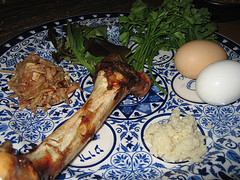By Suzanne Kurtz , JTA World News Service
WASHINGTON (JTA) — Of all the wedding presents Marilyn Fine received 36 years ago, the delicate English bone-china Passover seder plate is still her most cherished gift.
“I wish I could display it all year round,” says Fine, 59, a Jewish educator from Silver Spring, Md.
It’s too big for her china cabinet, she says, so Fine looks forward to the yearly festival of the unleavened bread when she can take out the seder plate and show it off.
Laurie Blumberg-Romero of Denver shows off the silver-and-white porcelain seder plate she received for her wedding, and also sets her Passover table with another plate of equal value in her eyes — the one her son made in the first grade that she says “connects him to the holiday.”
“It’s always, always on the table because it’s so cute,” says Blumberg-Romero, a 38-year-old hospital administrator.
Regardless of the design or designer — renowned artist or artistic child — one thing remains the same for each plate: a designated placeholder for each of the traditional food items necessary for telling the Passover story.
For a holiday that commands Jews to remember the ancient Israelites’ exodus from slavery to freedom, are we free to adapt these food items to tell our own stories?
A few years ago, during a visit to Arlington National Cemetery in Virginia, I heard of a Jewish soldier during the American Civil War who wanted to celebrate Passover but could not find suitable ingredients for making charoset. Instead of creating an edible concoction to represent the bricks made by the Israelite slaves, the soldier used an actual brick.
Despite its physical authenticity, I wondered if this resourceful symbol would have been considered kosher for Passover?
“There have always been variances in the community,” says Rabbi Joel Levenson of Congregation B’nai Jacob in Woodbridge, Conn. “While there are items that make it a seder plate, it’s important to ask, does this [symbol] fulfill the point?”
If the idea of pesticides on your karpas is as appealing as the Ten Plagues, Max Goldberg of the popular food blog livingmaxwell.com suggests using ingredients like grass-fed eggs and organic honey, almond butter and wine to create a seder plate devoid of chemical substances and synthetic growth hormones.
“For many [people], holidays do not mean a holiday from eating healthy food, and Passover can be a difficult time. So what do you do for them?” Goldberg asks. The food items on the seder plate have meaning, but “food is also medicine, regardless of the occasion,” he says.
After becoming a vegetarian 21 years ago, the idea of using an animal bone to represent the pascal sacrifice posed a serious problem for Heidi Krizer Daroff, a mother of two from Potomac, Md. She decided to use a roasted potato in lieu of the roasted shank bone.
“I see the seder plate as representing freedom, and to me, a dead bone was offensive,” she says.
But freedom is not just the absence of shank bones or slavery.
“There is a very modern-day context to the story,” says Rabbi Levi Shemtov, head of the American Friends of Lubavitch office in Washington, D.C.
He says seder participants also must remember those Jews still in bondage and unable to attend a seder. Shemtov leaves an empty seat at his packed Passover dinners as a symbol of solidarity with Israeli soldier Gilad Shalit, who has been held captive in the Gaza Strip since June 2006.
Before Jews were permitted to leave the Soviet Union without difficulty in 1989, it became a custom to place an extra piece of matzoh on the seder plate as a symbol of solidarity with refuseniks, those Soviet Jews whose applications had been refused, says Rabbi Isaac Jeret of Congregation Ner Tamid of South Bay in Rancho Palos Verdes, Calif.
“We tell our stories through our ritual items, and the seder plate tells our story as Jews,” Jeret says. “The point is to remind us that we can be liberated. The day the seder plate becomes stagnant is the day Jews are no longer under any threat, but we’re not there yet.”
